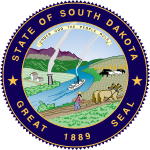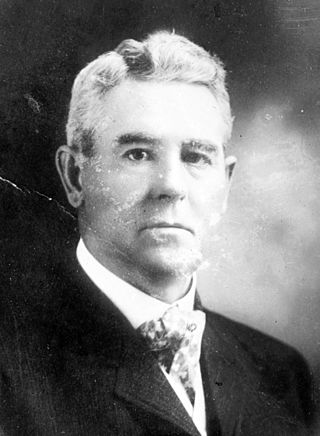
Robert Scadden Vessey was the seventh Governor of South Dakota. Vessey, a Republican from Wessington Springs, served from 1909 to 1913.

George W. Egan was an American attorney. He was a colorful and controversial political figure from Sioux Falls, South Dakota.
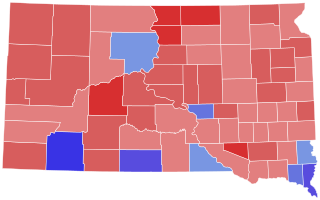
The 1978 South Dakota gubernatorial election was held on November 7, 1978, to elect a Governor of South Dakota. Republican nominee Bill Janklow was elected, defeating Democratic nominee Roger D. McKellips.

The 1894 South Dakota gubernatorial election was held on November 6, 1894. Incumbent Republican Governor Charles H. Sheldon ran for re-election to a second term. Despite facing a thread of defeat at the Republican convention, Sheldon was renominated unanimously. In the general election, he faced Populist nominee Isaac Howe, a Spink County Judge; James A. Ward, the former state chairman of the South Dakota Democratic Party; and Prohibition nominee M. D. Alexander. The election was largely a replay of the gubernatorial elections of 1890 and 1892, with the Farmers' Alliance candidate placing second and the Democratic nominee placing a distant third. This time, however, Sheldon won an outright majority and the Democratic Party's vote share shrunk to just 11%, its worst performance in state history.
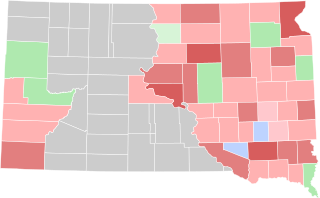
The 1892 South Dakota gubernatorial election was held on November 8, 1892. Incumbent Republican Governor Arthur C. Mellette declined to seek re-election to a third term. Former territorial legislator Charles H. Sheldon was nominated by the Republican Party as Mellette's replacement, and he faced former legislator Abraham Lincoln Van Osdel, a leader in the South Dakota Farmers' Alliance and the nominee of the Independent Party, along with Democratic nominee Peter Couchman, in the general election. The result was largely a replay of the 1890 election, with Sheldon winning by a large margin, but only a plurality, and Van Osdel taking second place over Couchman.

The 1904 South Dakota gubernatorial election was held on November 8, 1904. Incumbent Republican Governor Charles N. Herreid declined to run for re-election to a third term. Clark County State's Attorney Samuel H. Elrod won the Republican nomination to run as Herreid's successor, and he faced Democratic nominee Louis N. Crill, the former president of the state Senate, and former U.S. Congressman Freeman Knowles, the Socialist nominee. For the first time since 1894, the Democratic and Populist Parties nominated separate candidates. Ultimately, the split in the two parties did not prove dispositive; Elrod defeated Crill and the other candidates in a landslide.

The 1906 South Dakota gubernatorial election was held on November 6, 1906. Incumbent Republican Governor Samuel H. Elrod ran for re-election, but was defeated for renomination at the Republican convention by former Attorney General Coe I. Crawford. In the general election, Crawford was opposed by the Democratic nominee, former State Representative John A. Stransky of Brule County. Crawford had little difficulty defeating Stransky in a landslide, largely matching Elrod's margin of victory from two years earlier.

The 1962 United States Senate election in South Dakota took place on November 6, 1962. Incumbent Republican Senator Francis H. Case ran for re-election to a third term. He won the Republican primary against Attorney General A. C. Miller, but shortly after the primary, died. The Republican State Central Committee named Lieutenant Governor Joseph H. Bottum as Case's replacement on the ballot, and Governor Archie Gubbrud appointed Bottum to fill the vacancy caused by Case's death. In the general election, Bottum was opposed by Democratic nominee George McGovern, the Director of Food for Peace and the former U.S. Congressman from South Dakota's 1st congressional district. The contest between Bottum and McGovern was quite close, with McGovern narrowly defeating him for election by just 597 votes, making him the first Democrat to win a Senate election in South Dakota since William J. Bulow's win in 1936.

The 1908 South Dakota gubernatorial election was held on November 3, 1908. Incumbent Republican Governor Coe I. Crawford opted to run for the U.S. Senate rather than run for re-election. State Senator Robert S. Vessey narrowly won the Republican primary over former State Representative John L. Browne and advanced to the general election, where he faced the Democratic nominee, former Governor Andrew E. Lee. Though Vessey's performance was significantly reduced from Crawford's performance in 1906, he still defeated Lee by a wide margin.

The 1912 South Dakota gubernatorial election was held on November 5, 1912. Incumbent Republican Governor Robert S. Vessey declined to run for re-election to a third term. Lieutenant Governor Frank M. Byrne won the Republican primary to succeed Vessey, and then faced State Senator Edwin S. Johnson, the Democratic nominee, in the general election. Byrne only narrowly defeated Johnson, winning just 49% of the vote to Johnson's 46%, the closest gubernatorial election since 1898.

The 1950 South Dakota gubernatorial election was held on November 7, 1950. Incumbent Republican Governor George T. Mickelson was unable to seek re-election to a third term due to newly imposed term limits. Accordingly, a competitive race to replace him ensued. Attorney General Sigurd Anderson won a slim plurality in the Republican primary, barely exceeding 35% and narrowly avoiding having the Republican nomination sent to the state party convention. In the general election, Anderson faced State Representative Joe Robbie. Anderson easily defeated Robbie, winning his first term with 61% of the vote to Robbie's 39%.

The 1948 South Dakota gubernatorial election was held on November 2, 1948. Incumbent Republican Governor George T. Mickelson ran for re-election to a second term. He was opposed by Democrat Harold J. Volz, a businessman and the former chairman of the Tripp County Democratic Party. Both Mickelson and Volz were the only candidates of their parties to file for Governor, ensuring that they won their respective nominations unopposed and removing the race from the primary ballot. In the general election, Mickelson had little difficulty defeating Volz. Though Republican presidential nominee Thomas E. Dewey only narrowly won the state over President Harry S. Truman, Mickelson's popularity allowed him to win re-election in a landslide, receiving 61% of the vote to Volz's 39%.

The 1916 South Dakota gubernatorial election was held on November 7, 1916. Incumbent Republican Governor Frank M. Byrne declined to seek re-election to a third term. Lieutenant Governor Peter Norbeck won the Republican primary to succeed him, and in the general election faced State Representative Orville V. Rinehart. Norbeck won his first term as Governor in a landslide over Rinehart.

The 1944 South Dakota gubernatorial election was held on November 7, 1944. Incumbent Republican Governor Merrell Q. Sharpe ran for re-election to a second term. He was opposed Lynn Fellows, a former State Representative from Aurora County the 1942 Democratic nominee for Attorney General, in the general election; both Sharpe and Fellows won their primaries unopposed. In the general election, Sharpe easily defeated Fellows, far outpacing even Republican presidential nominee Thomas E. Dewey, who won the state in a landslide.
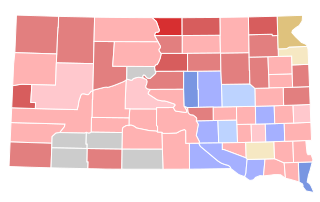
The 1922 South Dakota gubernatorial election was held on November 7, 1922. Incumbent Republican Governor William H. McMaster ran for re-election to a second term. After beating back a challenge in the Republican primary from perennial candidate George W. Egan, McMaster advanced to the general election, where he faced former State Senate President Louis N. Crill, the Democratic nominee, and suffragist Alice Lorraine Daly, the Nonpartisan League's nominee, and the first woman to run for governor. McMaster won by a large margin, but the race was considerably narrower than the 1920 election.
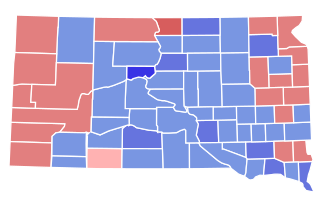
The 1928 South Dakota gubernatorial election was held on November 6, 1928. Incumbent Democratic Governor William J. Bulow ran for re-election to a second term. In the general election, he faced Attorney General Buell F. Jones, the Republican nominee. Despite Republican presidential nominee Herbert Hoover overwhelmingly defeating Democratic nominee Al Smith overwhelmingly in South Dakota, Bulow defeated Jones by a decisive margin to retain the governorship. In so doing, he became the first Democratic candidate for Governor to receive a majority of the vote in the state's history.

The 1936 South Dakota gubernatorial election was held on November 3, 1936. Incumbent Democratic Governor Tom Berry ran for re-election to a third term, the first Governor of South Dakota to do so. Berry was challenged by Republican Leslie Jensen, the former Collector of Internal Revenue for the state of South Dakota. Both Berry and Jensen won their primaries uncontested and advanced to the general election. Some drama surrounded the potential candidacy of Democratic State Auditor George O'Neill as an independent candidate for Governor or, in the alternative, his cross-party endorsement of Jensen; after initially announcing his campaign and hedging, O'Neill dropped out of the race in September and endorsed the Democratic ticket in the state, including Berry.

The 1938 South Dakota gubernatorial election was held on November 8, 1938. Incumbent Republican Governor Leslie Jensen declined to seek re-election and instead unsuccessfully ran for the U.S. Senate. Harlan J. Bushfield, the former chairman of the South Dakota Republican Party, won the Republican primary to succeed Jensen. In the general election, he faced Democratic nominee Oscar Fosheim, a state representative from Miner County, in the general election. Bushfield defeated Fosheim by a relatively close margin, winning his first term as governor.

The 1940 South Dakota gubernatorial election was held on November 5, 1940. Incumbent Republican Governor Harlan J. Bushfield sought re-election to a second term. After winning the Republican primary by a large margin, he faced Democrat Lewis W. Bicknell, former Day County State's Attorney, in the general election. Though Bushfield underperformed Republican presidential nominee Wendell Willkie, who won the state in a landslide, he nonetheless defeated Bicknell by a wide margin to easily win re-election.

The 1942 South Dakota gubernatorial election was held on November 3, 1942. Incumbent Republican Governor Harlan J. Bushfield declined to seek re-election to a third term and instead successfully ran for the U.S. Senate. A crowded Republican primary developed to succeed him, and because no candidate received 35% of the vote, the nomination was decided at the state Republican convention, where former Attorney General Merrell Q. Sharpe, the second-place finisher in the primary, won the nomination. In the general election, Sharpe faced Democratic nominee Lewis W. Bicknell, the 1940 Democratic nominee for governor. Aided by the national Republican landslide, Sharpe defeated Bicknell in a landslide.

